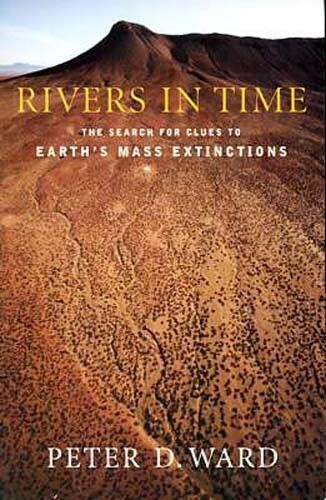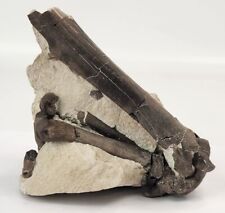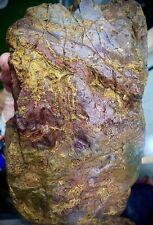Rivers in Time Search Clues Mass Extinction Permian Triassic Jurassic Cretaceous For Sale

When you click on links to various merchants on this site and make a purchase, this can result in this site earning a commission. Affiliate programs and affiliations include, but are not limited to, the eBay Partner Network.
Rivers in Time Search Clues Mass Extinction Permian Triassic Jurassic Cretaceous:
$25.99
Click here to see 1,000 archaeology/ancient history books and 2,000 ancient artifacts, antique gemstones, antique jewelry!
Rivers in Time: The Search for Clues to Earth’s Mass Extinctions by Peter D. Ward.
NOTE: We have 75,000 books in our library, almost 10,000 different titles. Odds are we have other copies of this same title in varying conditions, some less expensive, some better condition. We might also have different editions as well (some paperback, some hardcover, oftentimes international editions). If you don’t see what you want, please contact us and ask. We’re happy to send you a summary of the differing conditions and prices we may have for the same title.
DESCRIPTION: Softcover: 315 pages. Publisher: Columbia University Press; (2000). Several times in the distant past, catastrophic extinctions have swept the Earth, causing more than half of all species, from single-celled organisms to awe-inspiring behemoths, to suddenly vanish and be replaced by new life forms. Today the rich diversity of life on the Earth is again in grave danger, and the cause is not a sudden cataclysmic event but rather humankind's devastation of the environment. Is life on our planet teetering on the brink of another mass extinction? In this absorbing new book, acclaimed paleontologist Peter D. Ward answers this daunting question with a resounding yes.
Elaborating on and updating Ward's previous work, “The End of Evolution”, “Rivers in Time” delves into his newest discoveries. The book presents the gripping tale of the author's investigations into the history of life and death on Earth through a series of expeditions that have brought him ever closer to the truth about mass extinctions, past and future. First describing the three previous mass extinctions; those marking the transition from the Permian to the Triassic periods 245 million years ago; the Triassic to the Jurassic 200 million years ago; and the Cretaceous to the Tertiary 65 million years ago, Ward assesses the present devastation in which countless species are coming to the end of their evolution at the hand of that wandering, potentially destructive force called “Homo sapiens”.
The book takes readers to the Philippine Sea, now eerily empty of life, where only a few decades of catching fish by using dynamite have resulted in eviscerated coral reefs, and a dramatic reduction in the marine life the region can support. Ward travels to Canada's Queen Charlotte Islands to investigate the extinctions that mark the boundary between the Triassic and Jurassic periods. He ventures also into the Karoo desert of southern Africa, where some of Earth's earliest land life emerged from the water and stood poised to develop into mammal form, only to be obliterated during the Permian/Triassic extinction. “Rivers of Time” provides reason to marvel and mourn, to fear and hope, as it bears stark witness to the urgency of the Earth's present predicament: Ward offers powerful proof that if radical measures are not taken to protect the biodiversity of this planet, much of life as we know it may not survive.
CONDITION: NEW. New oversized softcover. Columbia University (2002) 320 pages. Unblemished except for very mild edge and corner shelf wear to the covers, principally in the form of mild rubbing to the spine head, and very faint rubbing to the spine heel, and a small crease to the bottom corner of the back cover. Though the last few pages in the book echo the small corner crease to the bottom of the back cover, except for that the pages within the book are pristine; clean, crisp, unmarked, (otherwise) unmutilated, tightly bound, unambiguously unread. Condition is entirely consistent with new stock from a bookstore environment wherein new books might show minor signs of shelfwear, consequence of simply being shelved and re-shelved. Satisfaction unconditionally guaranteed. In stock, ready to ship. No disappointments, no excuses. PROMPT SHIPPING! HEAVILY PADDED, DAMAGE-FREE PACKAGING! #1410.1d.
PLEASE SEE IMAGES BELOW FOR JACKET DESCRIPTION(S) AND FOR PAGES OF PICTURES FROM INSIDE OF BOOK.
PLEASE SEE PUBLISHER, PROFESSIONAL, AND READER REVIEWS BELOW.
PUBLISHER REVIEW:
REVIEW: Is life on our planet teetering on the brink of another mass extinction? Acclaimed paleontologist Peter D. Ward answers with a resounding yes. Ward presents the gripping tale of his investigations into the history of life and death on Earth through a series of expeditions that have brought him ever closer to the truth about mass extinctions of the past Peter D. Ward is professor of geological sciences at the University of Washington, Seattle. He is the author of many books, including “Rare Earth”, “In Search of Nautilus”, “The End of Evolution”, and “On Methuselah's Trail”.
PROFESSIONAL REVIEWS:
REVIEW: Ward (Geology, University of Washington, Seattle) presents the results of his investigations into the history of life and death on earth, describing three previous mass extinctions and evaluating the present devastation in which countless species are coming to the end of their evolution due to human action. Rivers in Time is rich in information and ideas and masterfully portrays for non-paleontologists how data are collected from the fossil record and then used to test various concepts. The section on the modern mass extinction is superb, and it should concern us all. Highly recommended.
REVIEW: The pace of species extinction provoked by human rapacity may well now equal the rate of loss in the great mass extinction events that punctuate the history of life. We need a broad perspective on this most portentous of all ecological and evolutionary disasters, and who better than a paleontologist to provide it. Peter Ward ranks with the very best in this most fascinating profession, and his book should be read by all thinking and caring people.
REVIEW: The current extinction of species at the hand of Man, a crime that posterity will regard as more pernicious than the burning of the library of Alexandria, is investigated by Peter Ward with rare perception and depth of feeling. This is one of the science books every self-taught genius should have read this year.
READER REVIEWS:
REVIEW: I really like Peter Ward's books. He presently serves as my 'geological advisor', as I also am a geologist. He is not as dogmatic as some within the field of mass extinction, since he recognizes it is now becoming increasingly obvious that in most mass extinctions, these ancient 'killers' did not act alone. Early arguments in the debate of mass extinction, especially the Cretaceous-Tertiary (K/T) event, were in the form of either/or, (eg volcanism versus asteroid/comet impact), rather than one big event following and/or combining with another.
The old argument "one or the other" is now often questioned on the basis of statistics itself. You could just as well turn this logic around-if it so happened, that once in a proverbial blue moon in geological time (which is really long) TWO OR MORE events occurred at roughly the same time-wouldn't this produce a really big mass extinction??. Maybe to exterminate a large number of species against the backdrop of reasonable resistance of life to widespread extinction, more than one major event has to occur. This sort of scenario is supported, for example, by the many impact craters which have been dated and which have produce no mass extinctions. This is the general view espoused by this book. Maybe we should expect that for a 'mass extinction' event to produce a real killer blow, maybe life has to be wounded first.
Peter Ward in this book focusses on four mass extinctions- the P/T, the end Triassic, the K/T, and the present. There is good evidence for similarities -in the end Permian it is suggested to be due to life adapted to ice ages, then increased volcanism and increased CO2 with hothouse, and possible sea level changes. At the K/T it was ocean changes (?), then volcanism and increased CO2, and then impact. At the present a suprisingly similar situation appears to be occurring. Presently now it's climate change (drying of the Mediterranean, prevalence of ice ages), evolution of man (from these two possibly), and now carbon dioxide emission.
The end Triassic, along with the end Permian, are the least understood extinction events. Peter Ward takes us to the red sandstones of the Karoo (P/T), the Queen Charlotte Islands off the coast of Canada (end Triassic), and Soviet Georgia in the former USSR (K/T), to unravel some of these mysteries. The last portion of the book looks at the present extinction event-with man as the major influence. Peter Ward mentions that the start of the Triassic worldwide often contains red-beds, even near the poles-suggesting hothouse conditions. From my experience in New South Wales, Australia, this is true. The start of the Triassic in NSW is interesting in that it seems also utterly barren of coal, despite a lot of coal through the Permian. Something happened; the organisms were all dead, apparently. There are a lot of red-beds at the boundary too, hothouse conditions, even though New South Wales was near the poles at the time. It is interesting to see these sort of patterns worldwide, something strange indeed seems to have been going on at the start of the Triassic/end Permian. A good read, and a good guide to updates on extinction scenarios.
REVIEW: I've read one other book by Peter D. Ward, "The call of distant mammoths," and enjoyed it immensely, so when I saw "Rivers in Time," and recognized the author's name I snatched it up right away. The first part of this book contains condensed excerpts from earth's history, with particular emphasis on the famous and most notable extinction events found in the strata. This is preceded, and sometimes interspersed, with a brief history of geology and paleontology. Ward covers highlights relating to methods of dating sedimentary rocks using fossils, and how those techniques are anchored in radiometric dating. Ward introduces some particularly insightful information derived from some of his own field work. This adds a nice touch, and helps the reader understand a little of the flavor associated with being a field geologist. Chapter five for example, describes some work he did along the Pacific Coast of Canada, relating to the mass extinction at the end of the Triassic period, one of the five most catastrophic extinctions during the last 500 million years.
The Triassic, Permian, Cretaceous. Ward touches on them all, at least to some extent. Part III is about the Cretaceous/Tertiary event, when the dinosaurs went extinct. Here, as in other discussions, the text isn't just about the mechanics of extinction, but draws upon many ancillary issues that add depth and flavor to the discussion. Particularly interesting is his historical discussion of the scientific debate that led to the currently accepted view that a large comet or meteorite was a major (if not the major) contributor to the Cretaceous/Tertiary event. This part of the book contains interesting tidbits of information that many arm-chair scientists will, no doubt, enjoy. One passage that I underlined was the following: "... the pollen from normal plants found in that [New Mexico] region at the time suddenly disappeared, to be replaced by a pollen and spore assemblage made up almost completely of fern material. Ferns are well-known "disaster" species because they quickly move into and colonize disturbed landscapes, such as newly burned land."
Upon reading this I reflected upon the clear-cut that I had wandered across last year, with my horse, riding through the hills of the coast range in western Oregon. It was like a complete swath of destruction laid before me, with the shattered stumps of trees littering the landscape into the hazy distance, liberally punctuated with clumps of ferns. I have a hunch that the real point of Ward's book is found in section IV, "The modern mass extinction." The modern mass extinction started more than 10,000 years ago, and continues unabated today. Ward argues that we are witnessing one of the largest (if not the largest) extinction events in terms of total species lost. He lists several studies, some more alarming than others, indicating that the rate of extinction is probably in the range of thousands of species per year.
Ward never really forces the conclusion that people are the cause of these extinctions, but he does present some pretty incriminating data pointing to our species as the culprit. Mostly the evidence is circumstantial. A natural paradise exists without humans, humans arrive, mass extinction ensues. It happened in Hawaii (both with the indigenous population, and later with European invaders), the America, Australia, Madagascar, New Zeeland, and so forth. Ward also points to studies that help illustrate the complexity of extinction. Most extinctions are not caused by a single factor. And (as in the case of Madagascar) extinctions don't have to follow necessarily from hunting or otherwise deliberate killing of animals. They can (and do) happen because of habitat destruction and habitat compartmentalization and division. Something as simple as building a road through a wilderness area can be enough to tip the balance.
The cover of Ward's book shows a stark and barren landscape with dry riverbeds streaking through the sparse, brown bush. These rivers no longer run. The symbolism for extinction is deliberate. We all know that organisms and species die, but we still morn their passage. And when they die an untimely death, when their demise could have been prevented, it leaves a bitter taste of remorse and regret. As I read this book I found my self repeatedly wishing that the knowledge found between its covers could be imparted to every one of the politicians responsible for safeguarding what's left of our environment. As I tell my kids, enjoy the wilderness you see. Climb these glaciers, breath deeply the mountain air, because it is quickly disappearing. I'd call Ward's book valuable and informative, and hopefully it will spur a few to try and stop the onslaught, because extinction really is forever.
REVIEW: This book is by far one of the best books I have ever read. I now look at life in a completely different way. I was brought up in a strict Baptist home where the Bible was the only way, after reading this book I don't dismiss God but life is sure not how the Bible says it is. Peter writes this book in an informal way, which makes it very interesting; you can almost fell like you are there, taking a beginner like me into a very complicated world. I have discussed this book with others at work and found that no one that I talked to accepts evolution; they all think it's not real. I just feel so much more educated on the subject and thank Peter Ward for writing this book. It was great.
I always ship books Media Mail in a padded mailer. This book is shipped FOR FREE via USPS INSURED media mail (“book rate”). All domestic shipments and most international shipments will include free USPS Delivery Confirmation (you might be able to update the status of your shipment on-line at the USPS Web Site and free insurance coverage). A small percentage of international shipments may require an additional fee for tracking and/or delivery confirmation. If you are concerned about a little wear and tear to the book in transit, I would suggest a boxed shipment - it is an extra $1.00. Whether via padded mailer or box, we will give discounts for multiple purchases. International orders are welcome, but shipping costs are substantially higher.
Most international orders cost an additional $12.99 to $33.99 for an insuredshipment in a heavily padded mailer, and typically includes some form of rudimentary tracking and/or delivery confirmation (though for some countries, this is only available at additional cost). There is also a discount program which can cut postage costs by 50% to 75% if you’re buying about half-a-dozen books or more (5 kilos+). Rates and available services vary a bit from country to country. You can email or message me for a shipping cost quote, but I assure you they are as reasonable as USPS rates allow, and if it turns out the rate is too high for your pocketbook, we will cancel the sale at your request. ADDITIONAL PURCHASES do receive a VERY LARGE discount, typically about $5 per book (for each additional book after the first) so as to reward you for the economies of combined shipping/insurance costs. Your purchase will ordinarily be shipped within 48 hours of payment. We package as well as anyone in the business, with lots of protective padding and containers.
All of our shipments are sent via insured mail so as to comply with PayPal requirements. We do NOT recommend uninsured shipments, and expressly disclaim any responsibility for the loss of an uninsured shipment. Unfortunately the contents of parcels are easily “lost” or misdelivered by postal employees – even in the USA. That’s why all of our domestic shipments (and most international) shipments include a USPS delivery confirmation tag; or are trackable or traceable, and all shipments (international and domestic) are insured. We do offer U.S. Postal Service Priority Mail, Registered Mail, and Express Mail for both international and domestic shipments, as well United Parcel Service (UPS) and Federal Express (Fed-Ex). Please ask for a rate quotation. We will accept whatever payment method you are most comfortable with. If upon receipt of the item you are disappointed for any reason whatever, I offer a no questions asked return policy. Send it back, I will give you a complete refund of the purchase price (less our original shipping costs).
Most of the items I offer come from the collection of a family friend who was active in the field of Archaeology for over forty years. However many of the items also come from purchases I make in Eastern Europe, India, and from the Levant (Eastern Mediterranean/Near East) from various institutions and dealers. Though I have always had an interest in archaeology, my own academic background was in sociology and cultural anthropology. After my retirement however, I found myself drawn to archaeology as well. Aside from my own personal collection, I have made extensive and frequent additions of my own via purchases on (of course), as well as many purchases from both dealers and institutions throughout the world – but especially in the Near East and in Eastern Europe. I spend over half of my year out of the United States, and have spent much of my life either in India or Eastern Europe. In fact much of what we generate on Yahoo, Amazon and goes to support The Hermitage Museum in St. Petersburg, as well as some other worthy institutions in Europe connected with Anthropology and Archaeology.
I acquire some small but interesting collections overseas from time-to-time, and have as well some duplicate items within my own collection which I occasionally decide to part with. Though I have a collection of ancient coins numbering in the tens of thousands, my primary interest is in ancient jewelry. My wife also is an active participant in the "business" of antique and ancient jewelry, and is from Russia. I would be happy to provide you with a certificate/guarantee of authenticity for any item you purchase from me. There is a $2 fee for mailing under separate cover. Whenever I am overseas I have made arrangements for purchases to be shipped out via domestic mail. If I am in the field, you may have to wait for a week or two for a COA to arrive via international air mail. But you can be sure your purchase will arrive properly packaged and promptly - even if I am absent. And when I am in a remote field location with merely a notebook computer, at times I am not able to access my email for a day or two, so be patient, I will always respond to every email. Please see our "ADDITIONAL TERMS OF

Related Items:
Oreodont Right Leg Fossils In Matrix - White River Group - Brule Fm. - NE
$299.99
Sale Abstract Caffe By River 40"H X 40W Canvas Giclee Framed Winford 995 Now 395
$395.00
Large Once In Lifetime River Jasper 18+ Lbs Super Dense Super Awesomeness
$498.50



